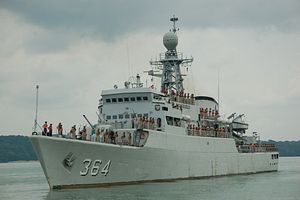It has been three years since President Joko “Jokowi” Widodo announced Indonesia’s grand maritime vision, the Global Maritime Fulcrum (GMF). Jokowi pledged to capitalize on Indonesia’s geographic position to make Indonesia a “fulcrum” of Indo-Pacific maritime activity. Iterated many times in his campaign manifesto and later at the 9th East Asian Summit at Naypyidaw in 2014, the vision now finally has an authoritative document titled “Indonesian Ocean Policy,” which was recently published by the Coordinating Ministry for Maritime Affairs.
There are two dimensions to the GMF: the strategic and economic. The strategic dimension envisions the Indonesian Navy as regional maritime power. To that end, the administration has pledged to increase defense spending to facilitate naval modernization. In the economic sector, the Jokowi administration envisions a more interconnected Indonesia. By pledging to develop ports, fisheries, and shipping, Jokowi hopes to decrease the development gap between the main and outer islands. Jokowi also hopes to better integrate Indonesian islands with global maritime trade routes by developing ports.
How fares the GMF? As the last three years have shown, Jokowi has been diligent in building the physical elements of the GMF. Ports are being upgraded to facilitate the much-lauded “sea toll road,” particularly in less developed islands such as Papua, in hopes of bringing equality in economic development. The Navy is acquiring new ships to replaced Indonesia’s ageing naval fleet. The most recent commissioning of the newest PKR frigate, the KRI Raden Eddy Martadinata-331, is just a small part of Indonesia’s upcoming naval modernization. The naval base at Natuna Island has also been modernized and upgraded to anticipate potential traditional and nontraditional security threats coming from the South China Sea.
However, despite Jokowi’s persistent focus on infrastructure and physical development, the largest hurdle that the GMF continues to face is messy maritime security governance.
Overlapping authorities pose a significant barrier to inter-agency coordination. Indonesia currently has 13 different agencies that are stakeholders in maritime security. This includes some of the major players, such as the Navy (TNI-AL), the Police, the Civil Service Investigators of ten different ministries – including Customs and Fisheries – and the fledgling Maritime Security Agency (Bakamla). These 13 agencies have yet to be integrated under a single command, which provides ample opportunities for miscommunication and lack of coordination.
One only needs to remember the time when the TNI-AL detained two boats to get a glimpse of the complexity of Indonesia’s maritime security governance. In 2014, the TB Bina Marine 75 tugboat and Bina Marine 76 barge were seized by the Indonesian Navy due to suspicions of smuggling. The TNI-AL indeed has the right to detain any suspicious vessels in Indonesian waters. However, smuggling also falls under the jurisdiction of Customs. Whose authority should supersede the other in this case? This unclear distinction of authority, caused by a confusing legal overlap, will often lead to cases of legal “turf wars” where each agency will fight for their share of credit, only to be further exacerbated by sectorial egoism.
For the remaining two years of Jokowi’s term in office, the highest priority should be to straighten out these tangled threads of maritime security governance. Without a robust and clearly defined framework or action plan, the physical elements of the GMF will continue to operate at limited efficiency simply because different agencies are always at each other’s necks.
To address these issues, there should be a serious legal review of the current maritime security regime. The review should target redundancies in maritime laws with a specific focus of clearing up potential “turf war” clauses. The tasks of each agency should be made explicitly clear, with little room for jurisdictional overlap. This will allow each agency to focus on their specific duties.
There also ought to be a centralized “command center” for the 13 maritime security agencies in order to lessen the probability of inter-agency clashes and to minimize lack of coordination. The Bakamla fits the bill; however, at the moment, it is still relatively powerless to act as a central command, both in operational and technical terms. There ought to be efforts to strengthen the position of the Bakamla as a central coordinating unit for all maritime security stakeholders.
Seeing these possibilities, it is essential for Indonesia to straighten out its complicated maritime security regime. Without substantial reform, Indonesia’s bid to become a regional maritime power will remain a pipe dream. Moreover, as the future maritime security environment becomes more complex, it is important that Indonesia’s maritime security agencies are well coordinated and not bickering with one another in the face of emerging maritime security threats that require dynamic and joint responses.
I.G.B. Dharma Agastia is a Lecturer at the International Relations Study Program at President University, Cikarang. The views and opinions expressed in this article are the author’s alone.

































